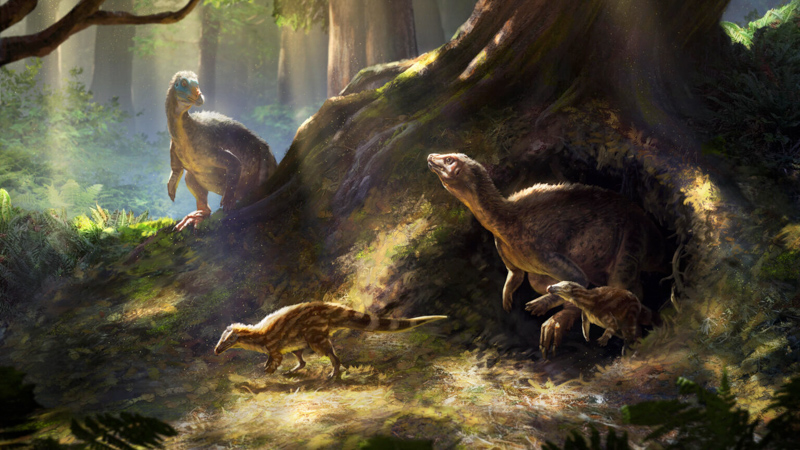Dig This: ‘Neglected’ Dinosaur Had Super Senses
For immediate release ‐ November 07, 2023
Paleontology
Contact: Jon Pishney, 919.707.8083. Images available upon request
 A family of Thescelosaurus emerges from safety to forage in the forests of the Hell Creek Formation, 66 million years ago. Image: Anthony Hutchings.
A family of Thescelosaurus emerges from safety to forage in the forests of the Hell Creek Formation, 66 million years ago. Image: Anthony Hutchings.
A CT scan of an often-overlooked, plant-eating dinosaur’s skull reveals that while it may not have been all that “brainy,” it had a unique combination of traits associated with living animals that spend at least part of their time underground, including a super sense of smell and outstanding balance. The work is the first to link a specific sensory fingerprint with this behavior in extinct dinosaurs.
The dinosaur in question, Willo, is a specimen housed at the North Carolina Museum of Natural Sciences. Willo is a Thescelosaurus neglectus – a small (12 feet or 3.6 meters long) but heavy (750 pounds or 340 kilograms) herbivore that lived in what is now North America just before the end-Cretaceous mass extinction event, 66 million years ago.
Willo’s scientific name roughly translates to “wonderful, overlooked lizard.” But David Button, a former Brimley Postdoctoral Scholar at the North Carolina Museum of Natural Sciences and North Carolina State University, decided to look more closely at this “overlooked” dinosaur’s skull. Button is currently a research associate at the University of Bristol in the U.K.
…
“The irony is that paleontologists generally think of these animals as pretty boring,” says Lindsay Zanno, associate research professor at NC State, head of paleontology at the North Carolina Museum of Natural Sciences, and co-author of the work.
…
“We found that Thescelosaurus heard low frequency sounds best, and that the range of frequencies it could hear overlaps with T. rex,” Zanno says. “This doesn’t tell us they were adapted to hearing T. rex vocalize, but it certainly didn’t hurt them to know when a major predator was tooling about in the area. More interesting to us was the fact that these particular deficiencies are often associated with animals that spend time underground.”
…
The research appears in Scientific Reports. Button is corresponding author. Willo is currently on display at the North Carolina Museum of Natural Sciences. Visitors to the museum will soon be able to explore the 3D skull and hearing capabilities of Willo for themselves in an interactive exhibit being built for the new Dueling Dinosaurs experience due to open in 2024.
Read the full article in NC State University News
For more information about our upcoming activities, conservation news and groundbreaking research, follow @NaturalSciences on Instagram, Twitter and Facebook.

